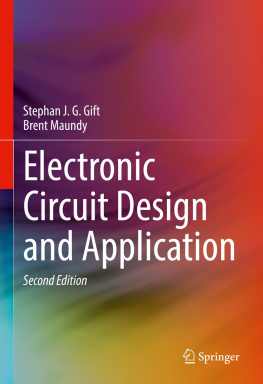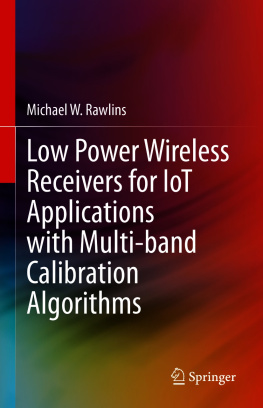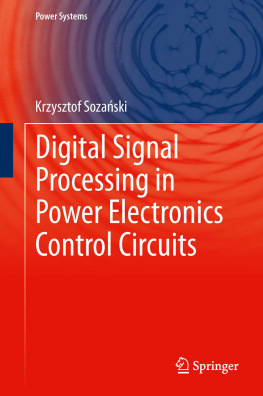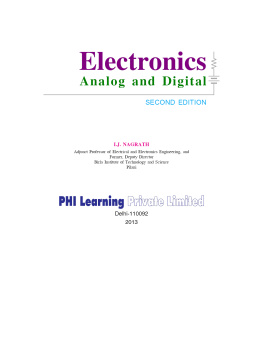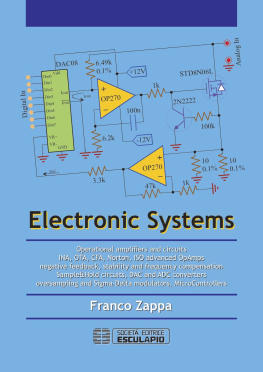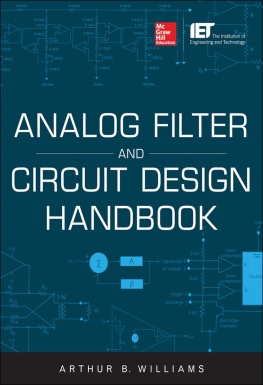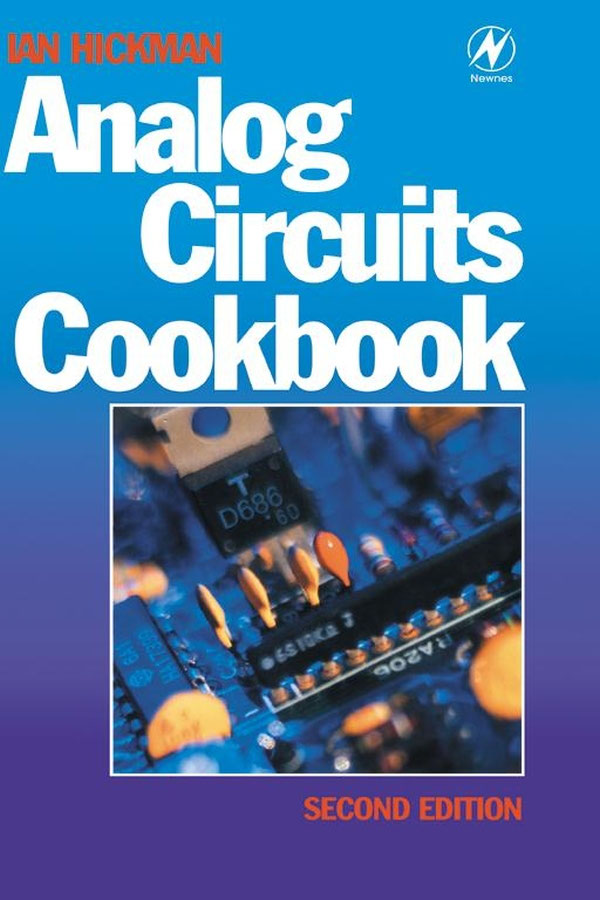Analog Circuits Cookbook
Second Edition
Ian Hickman
BSc (Hons), CEng, MIEE, MIEEE
Newnes
OXFORD AUCKLAND BOSTON JOHANNESBURG MELBOURNE NEW DELHI
Table of Contents
Cover image
Title page
Copyright page
Preface to second edition
1: Advanced circuit techniques, components and concepts
Negative approach to positive thinking
Negative inductor
Real pictures
Negative capacitance
Kundert filter
Acknowledgements
Logamps for radar and much more
Acknowledgements
Working with avalanche transistors
Filters using frequency-dependent negative resistance
So how does an FDNR work?
Big surprises in small packages
Discrete active devices
2: Audio
Low distortion audio frequency oscillators
Notes on free phasing
Creating other tone colours
Music in mind
Filter variations
Some other filter types
Camcorder dubber
3: Measurements (audio and video)
Four opamp inputs are better than two
DC accurate filter plays anti-alias role
Bootstrap base to bridge building
Mighty filter power in minuscule packages
Introduction
Some active probes
Acknowledgements
4: Measurements (rf)
Measuring detectors (Part 1)
Measuring detectors (Part 2)
Measuring L and C at frequency on a budget
Add on a spectrum analyser
Wideband isolator
5: Opto
Sensing the position
Acknowledgements
Bringing the optoisolator into line
Acknowledgements
Light update
A look at light
6: Power supplies and devices
Battery-powered instruments
Acknowledgements
The MOS controlled thyristor
Designers power supply
7: RF circuits and techniques
Homodyne reception of FM signals
FSK and the homodyne
FM reception
Homodyne in practice
LTPs and active double balanced mixers
Acknowledgements
Low power radio links
Noise
Noise the basics
Thermal noise model
Characteristics of random noise
Other types of noise
Narrowband noise
The noisy signal
Stationary, or not?
Carrier noise
Is it noise?
Understanding phase noise
Introduction
Noise in the receiver
Why phase noise is important
Phase noise of the LO
To B or not to B(ottom)?
The frequency discriminator
Frequency discriminator sensitivity
The measured results
Conclusions
Index
Copyright
Newnes
An imprint of Butterworth-Heinemann
Linacre House, Jordan Hill, Oxford OX2 8DP
Wildwood Avenue, Woburn, MA 0180[-2041
A division of Reed Educational and Professional Publishing Ltd
A member of the Reed Elsevier plc group
First published 1995
Second edition 1999
Ian Hickman 1995, 1999
All rights reserved. No part of this publication may be reproduced in any material form (including photocopying or storing in any medium by electronic means and whether or not transiently or incidentally to some other use of this publication) without the written permission of the copyright holder except in accordance with the provisions of the Copyright, Designs and Patents Act 1988 or under the terms of a licence issued by the Copyright Licensing Agency Ltd, Tottenham Court Road, London, England WIP 9HE. Applications for the copyright holders written permission to reproduce any part of this publication should be addressed to the publishers
British Library Cataloguing in Publication Data
A catalogue record for this book is available from the British Library.
ISBN 7506 42343
Library of Congress Cataloguing in Publication Data
A catalogue record for this book is available from the Library of Congress.
Typeset by Tek-Art, Croydon, Surrey
Printed and bound in Great Britain by
BiddIes Ltd, Guildford and Kings Lynn

Preface to second edition
Electronics World is undoubtedly the foremost electronics magazine in the UK, being widely read by both professional electronics engineers on the one hand and electronics hobbyists and enthusiasts on the other, in the UK, abroad and indeed around the world. The first article of mine to feature in the magazine, then called simply Wireless World, appeared back in the very early 1970s. Or was it the late 1960s; I cant remember. Since then I have become a more frequent and latterly a regular contributor, with both the Design Brief feature and occasional longer articles and series. With their straightforward non-mathematical approach to explaining modern electronic circuit design, component applications and techniques, these have created some interest and the suggestion that a collection of them might appear in book form found general approval among some of my peers in the profession. The first edition of this book was the result. A sequel, Hickmans Analog and R.F. Circuits, containing a further selection of articles published in Electronics World (as it is now known), was published subsequently.
Since the appearance of the first edition of the Analog Circuits Cookbook in 1995, a lot of water has flowed under the bridge, in technical terms. Some of the articles it contains are thus no longer so up-to-the-minute, whilst others are still entirely relevant and very well worth retaining. So this second edition of the Analog Circuits Cookbook has been prepared, retaining roughly half of the articles which appeared in the first edition, and replacing the rest with other articles which have appeared more recently in Electronics World.
Inevitably, in the preparation for publication of a magazine which appears every month, the occasional typo crept into the articles as published, whilst the editorial exigencies of adjusting an article to fit the space available led to the occasional pruning of the text. The opportunity has been taken here of restoring any excised material and of correcting all (it is hoped) errors in the articles as they appeared in the magazine. The articles have been gathered together in chapters under subject headings, enabling readers to home in rapidly on any area in which they are particularly interested. A brief introduction has also been added to each, indicating the contents and the general drift of the article.
Advanced circuit techniques, components and concepts
Negative approach to positive thinking
Negative components
Negative components may not be called for every day, but can be extremely useful in certain circumstances. They can be easily simulated with passive components plus opamps and one should be aware of the possibilities they offer.
There is often felt to be something odd about negative components, such as negative resistance or inductance, an arcane aura setting them apart from the real world of practical circuit design. The circuit designer in the development labs of a large firm can go along to stores and draw a dozen k resistors or half a dozen 10 F tantalums for example, but however handy it would be, it is not possible to go and draw a 4.7 k resistor. Yet negative resistors would be so useful in a number of applications; for example when using mismatch pads to bridge the interfaces between two systems with different characteristic impedances. Even when the difference is not very great, for example testing a bandpass filter using a network analyser, the loss associated with each pad is round 6 dB, immediately cutting 12 dB off how far down you can measure in the stopband. With a few negative resistors in the junk box, you could make a pair of mismatch pads with 0 dB insertion loss each.



